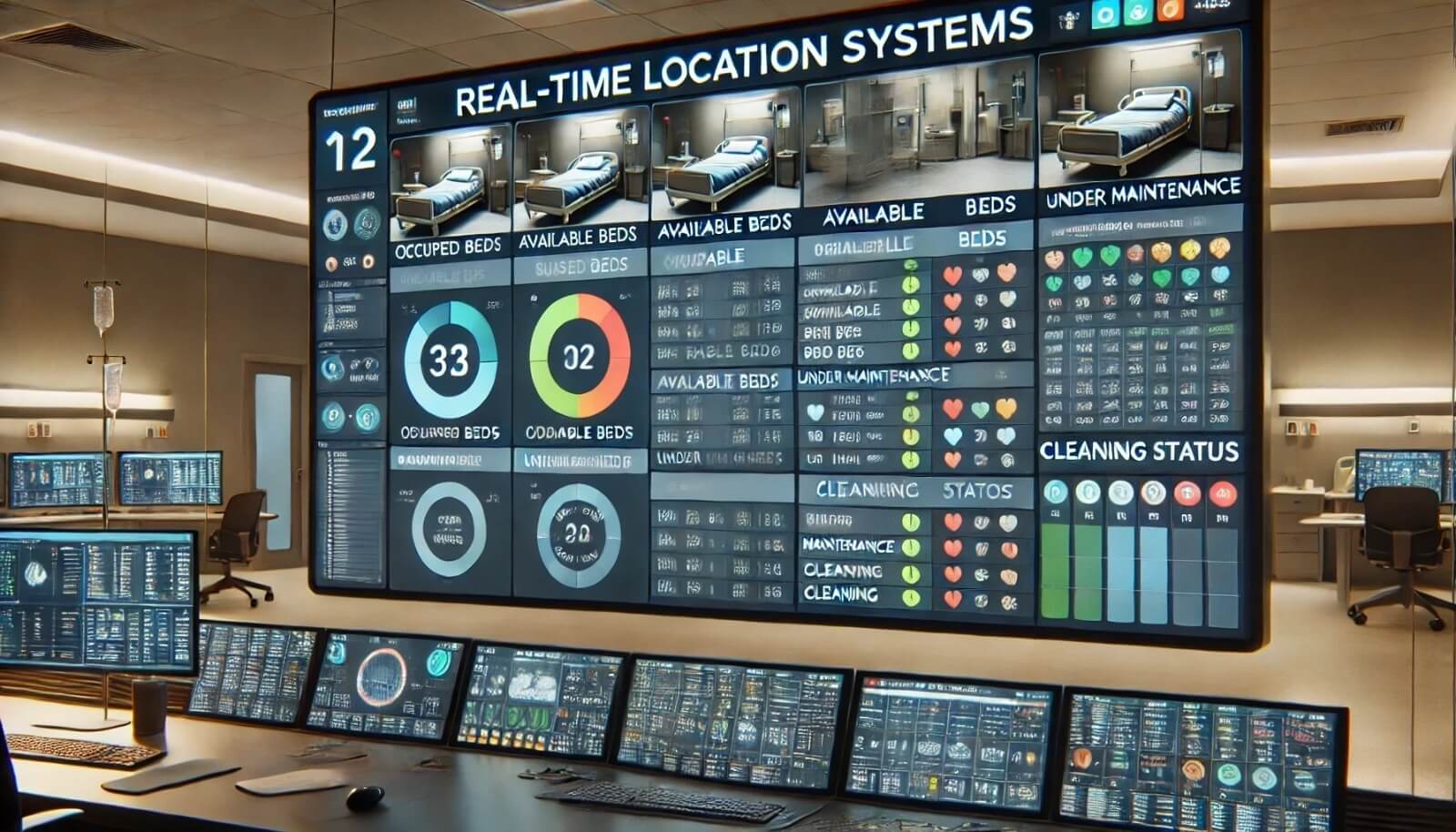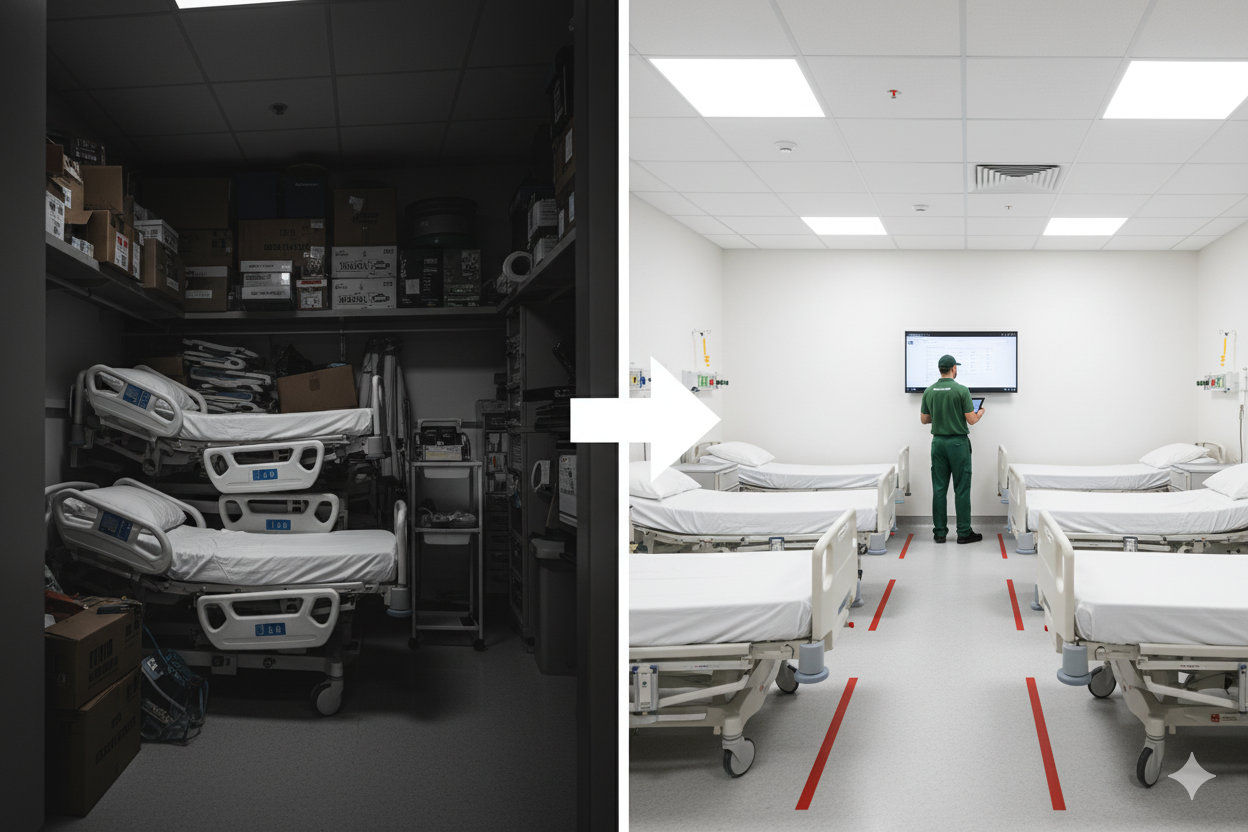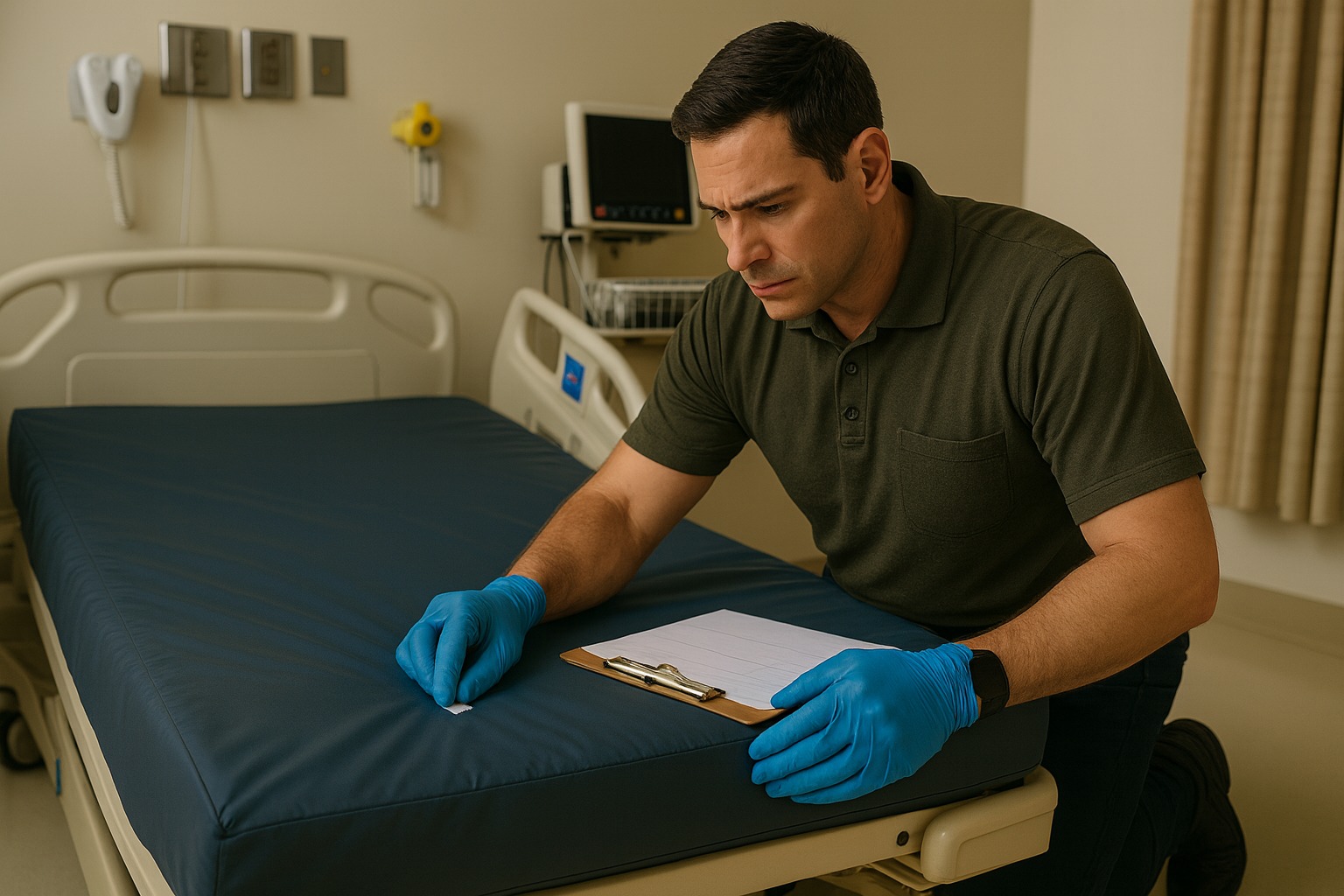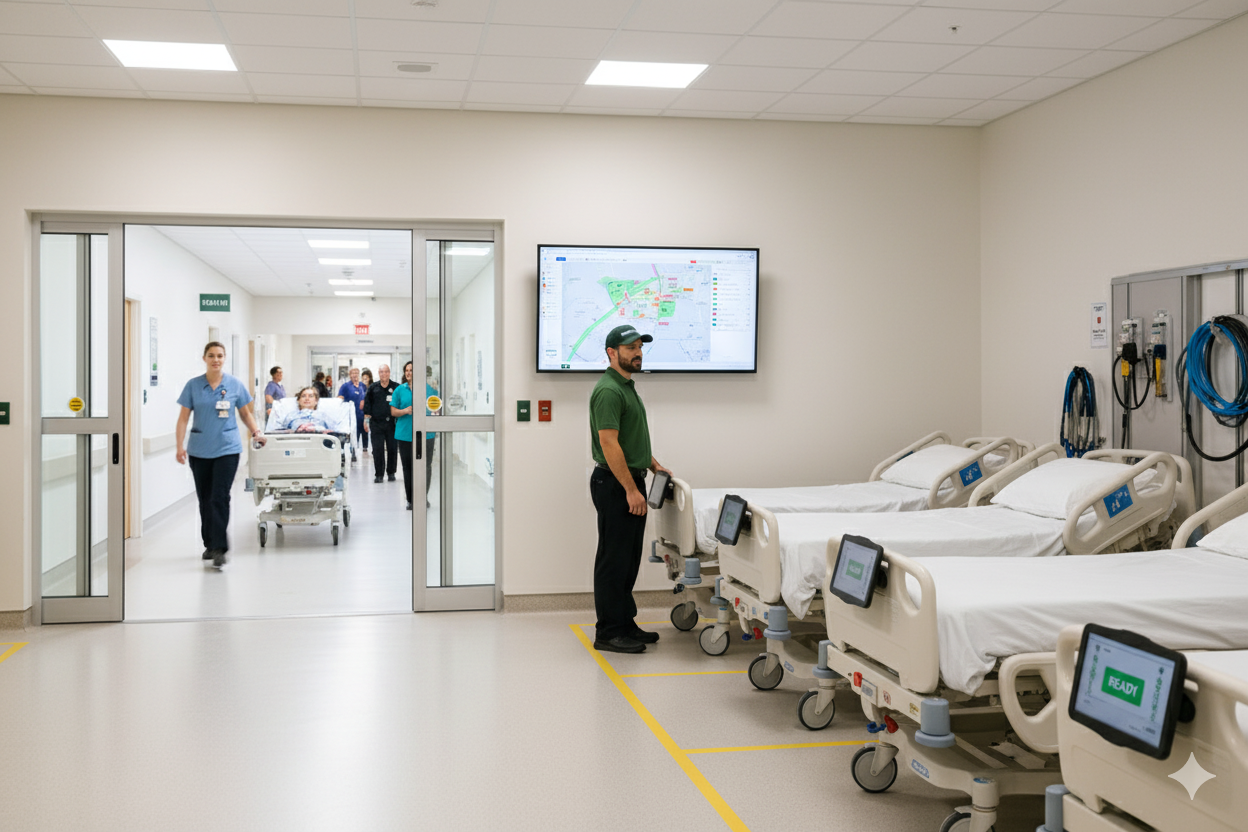
Hospital beds are one of the most essential yet often overlooked assets in healthcare facilities. Efficient bed utilization directly impacts patient flow, operational efficiency, and hospital revenue. Yet, many hospitals still struggle with inefficient bed tracking, poor bed transport coordination, and inadequate storage solutions, leading to delays in care, patient dissatisfaction, and increased costs.
By leveraging transport support, real-time availability tracking through RTLS (Real-Time Location Systems), and optimized bed storage management, hospitals can maximize bed utilization, streamline operations, and improve patient outcomes. This article explores these critical aspects of bed management and how modern solutions can revolutionize hospital efficiency.
The Challenge of Inefficient Bed Utilization
Hospitals face several challenges when it comes to bed utilization:
- Delays in patient transport slow down bed turnover, keeping beds occupied longer than necessary.
- Lack of real-time availability tracking results in misallocated resources and increased wait times.
- Poor storage management leads to cluttered hallways, inefficient space usage, and difficulties in locating available beds.
These inefficiencies can lead to longer patient wait times, reduced hospital revenue, and increased operational costs. Addressing these challenges requires a strategic, data-driven approach to bed transport, real-time tracking, and storage optimization.
Transport Support: The Key to Faster Bed Turnover
Why Bed Transport is Critical to Bed Utilization
A hospital bed sitting empty in a room doesn’t necessarily mean it’s available for the next patient. Often, delays in transport services keep beds from being properly cleaned, relocated, or reassigned. Without a structured bed transport system, hospitals experience:
- Extended discharge-to-admission times, creating patient bottlenecks in emergency departments.
- Slow response times from transport teams, resulting in delays in moving patients to their next point of care.
- Inefficient coordination between departments, leading to miscommunications and logistical errors.
Optimizing Bed Utilization Through Smart Management and Training
At Emeritus, we ensure hospitals maximize their bed utilization by implementing strategic processes that improve efficiency, reduce downtime, and extend equipment lifespan.
- Department-Specific Par Levels
We help hospitals set department-specific par levels, ensuring that each unit has the right type and quantity of beds needed for optimal operations. By proactively managing inventory, we prevent shortages and excesses that can disrupt patient care.
- Streamlining Bed Repairs
To minimize downtime, we move beds to and from the repair shop, expediting the repair process and getting functional beds back into circulation faster. This reduces bed shortages and ensures a steady availability of operational equipment.
- Transport Team Training
Proper bed transport is critical for preventing damage to both beds and hospital facilities. We provide targeted training for transport teams, focusing on:
- Safe handling practices to prevent damage during movement.
- Efficient workflows to reduce bed turnover delays and support patient flow.
- Best practices to minimize unnecessary repairs caused by improper transport.
By integrating par-level management, streamlined repair logistics, and expert training, we enhance hospital efficiency, improve patient flow, and extend the life of critical equipment.
Real-Time Availability and RTLS Management
Why Real-Time Tracking Matters
Many hospitals struggle with bed availability due to outdated or manual tracking systems, leading to:
- Misallocated beds causes excessive renting.
- Delays in patient admissions as staff manually confirm bed status.
- Interdepartmental confusion over which beds are occupied, in cleaning, or truly available.
RTLS: A Smarter Approach to Bed Management
Real-Time Location Systems (RTLS) provide a tech-driven solution for efficient bed tracking. With RTLS-enabled beds, hospitals can:
- Monitor Bed Status in Real Time – RTLS sensors provide instant updates on bed location, occupancy, and cleaning status.
- Enhance Staff Efficiency – Nurses, transport teams, and bed managers can quickly locate available beds, reducing wasted time.
- Reduce Patient Wait Times – Emergency rooms and ICUs receive real-time bed availability updates, improving patient flow and coordination.
Our Role in RTLS Optimization
At Emeritus, we ensure real-time RTLS accuracy by:
- Ensuring RTLS tags remain attached to beds for continuous tracking.
- Replacing RTLS batteries during preventive maintenance (PM) to avoid tracking failures.
- Verifying location accuracy, helping hospitals optimize bed utilization and streamline transport logistics.
How RTLS Improves Efficiency and Reduces Costs
By eliminating manual bed tracking and reducing errors, RTLS technology helps hospitals:
✔ Optimize resource allocation – Ensuring beds are always in use and not sitting idle.
✔ Improve patient satisfaction – Reducing delays in bed assignments and improving hospital workflows.
✔ Reduce operational costs – Cutting wasted staff hours spent searching for available beds.
When combined with automated transport requests and proactive maintenance, RTLS-powered bed tracking creates a seamless, efficient, and cost-effective bed management system.
Bed Storage Management: Ensuring Beds Are Available When Needed
The Problem with Poor Bed Storage
Many hospitals struggle with storing extra beds efficiently, leading to:
- Hallways cluttered with unused beds, creating safety hazards.
- Difficulty in locating stored beds when patient volume suddenly increases.
- Increased wear and tear on beds, as improper storage can cause damage over time.
Best Practices for Bed Storage Management
- Designated Storage Areas
- Hospitals should allocate dedicated storage spaces that are easily accessible for quick deployment during peak patient demand.
- Bed Storage PAR Levels
- Setting par levels (minimum and maximum bed stock levels per department) ensures that beds are readily available without excess clutter.
- RFID & RTLS for Inventory Tracking
- Using RFID or RTLS tracking for stored beds allows staff to quickly locate and deploy beds when needed.
- Preventative Maintenance for Stored Beds
- Regular inspections and preventative maintenance should be scheduled for stored beds to ensure they are patient-ready when needed.
Why Proper Bed Storage Matters
Proper bed storage solutions:
- Prevent bed shortages during high patient volumes.
- Reduce damage to beds, increasing their lifespan and lowering replacement costs.
- Improve hospital efficiency, ensuring beds are available where and when they’re needed.
The Financial and Operational Benefits of Improved Bed Utilization
By implementing structured transport support, real-time tracking, and optimized bed storage, hospitals can:
- Reduce patient wait times by ensuring beds are turned over quickly.
- Decrease operational costs through better resource allocation.
- Enhance patient care by eliminating inefficiencies in bed assignments.
- Improve compliance with regulatory requirements by maintaining accurate bed utilization data.
An effective bed management strategy is not just about logistics—it’s about delivering better healthcare.
Emeritus: Your Partner in Bed Utilization Excellence
At Emeritus, we specialize in helping hospitals optimize bed utilization through data-driven strategies, cutting-edge tracking solutions, and expert bed maintenance services. Our Bed Maintenance 2.0 program ensures that your beds are always operational, efficiently managed, and ready to serve patients.
By partnering with Emeritus, your hospital can reduce inefficiencies, improve patient flow, and maximize the financial and operational benefits of a well-managed bed fleet.
Let’s work together to transform your bed management strategy and elevate patient care. Contact us today to learn more!










